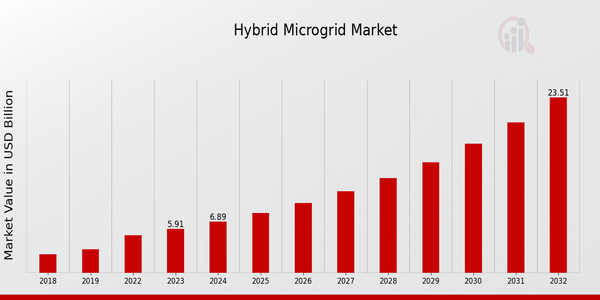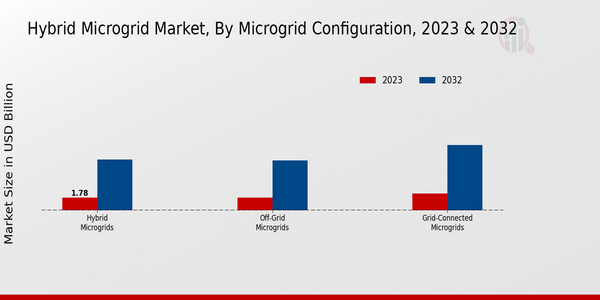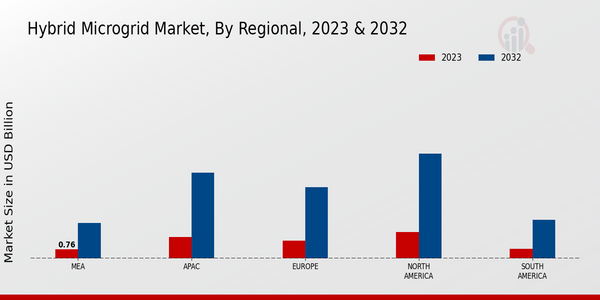Global Hybrid Microgrid Market Overview
As per MRFR analysis, the Hybrid Microgrid Market Size was estimated at 5.07 (USD Billion) in 2022. The Hybrid Microgrid Industry is expected to grow from 5.91 (USD Billion) in 2023 to 23.5 (USD Billion) by 2032. The Hybrid Microgrid Market CAGR (growth rate) is expected to be around 16.58% during the forecast period (2024 - 2032).
Key Hybrid Microgrid Market Trends Highlighted
The Hybrid Microgrid Market is experiencing notable growth, propelled by several key market drivers. Increasing demand for renewable energy sources, coupled with the need for energy security and resilience in the face of natural disasters and rising energy costs, is steering adoption towards hybrid microgrid systems. These systems facilitate a blend of conventional and renewable energy sources, enhancing energy efficiency and sustainability. Furthermore, government initiatives promoting clean energy adoption and investments in smart grid technologies are critical drivers fueling market expansion.
Opportunities abound within the domain of hybrid microgrids, particularly in regions with limited access to centralized power grids. Remote areas can significantly benefit from the deployment of hybrid microgrids, providing reliable and decentralized energy solutions. Additionally, the trend towards digitization and the integration of advanced technologies such as IoT and AI into microgrid operations present new avenues for growth. These technologies enhance the monitoring, management, and optimization of energy consumption, making hybrid microgrids more efficient and user-friendly.
Recently, there has been a notable shift towards the development of community-based hybrid microgrid solutions, allowing localities to take charge of their energy resources and reduce dependency on national grids. The rising emphasis on climate change mitigation is compelling both public and private sectors to invest in sustainable energy solutions, showcasing a promising trend toward the proliferation of hybrid microgrids as a viable alternative energy landscape. As technology continues to innovate and the global energy landscape evolves, the hybrid microgrid market stands poised for transformation and expansion.

Source: Primary Research, Secondary Research, Market Research Future Database and Analyst Review
Hybrid Microgrid Market Drivers
Increasing Demand for Reliable and Resilient Energy Solutions
The Hybrid Microgrid Market Industry is witnessing a significant surge in demand for reliable and resilient energy solutions. This growth is driven by the increasing frequency and intensity of power outages across the globe, as well as the need for post-disaster recovery. Hybrid microgrids, which can integrate various energy sources such as solar, wind, and diesel generators, provide a robust solution to ensure continuous power supply, even in adverse conditions.
Moreover, the potential for energy independence fosters a further increase in demand among consumers and industries looking to minimize their dependency on traditional power grids. As stakeholders recognize the advantages of hybrid microgrids, the market is expected to experience significant growth, driven by the urgency to adopt innovative energy solutions. Additionally, governmental policies and financial incentives aimed at promoting renewable energy sources contribute to the expansion of the market landscape, making it a pivotal moment for the Hybrid Microgrid Market Industry.
The focus on transitioning to a sustainable energy ecosystem aligns seamlessly with the functionalities offered by hybrid microgrids, making them a vital component of future energy strategies.
Government Initiatives and Funding
Government initiatives and funding play a crucial role in driving the Hybrid Microgrid Market Industry. As more countries recognize the importance of diversifying energy sources and reducing reliance on conventional fossil fuels, they are implementing various policies and programs designed to encourage the development and adoption of hybrid microgrids. Financial incentives, grants, and subsidies are being put forth to stimulate investment in clean and renewable energy technologies, thereby promoting the growth of the hybrid microgrid market.
These initiatives not only support the establishment of hybrid microgrids but also aim to enhance energy security, create job opportunities, and reduce environmental impacts. Governments are increasingly collaborating with private sector players, fostering public-private partnerships to ensure the successful deployment of these advanced energy systems.
Technological Advancements in Energy Storage and Management Systems
Technological advancements in energy storage and management systems are significantly enhancing the operational efficiency of hybrid microgrids. Innovations in battery technologies, such as lithium-ion and flow batteries, are improving energy storage capabilities, enabling more effective integration of renewable resources and optimizing energy usage. These advancements facilitate better energy management, allowing hybrid microgrids to maintain stable power supply while responding to fluctuations in energy demand.
As the Hybrid Microgrid Market Industry continues to evolve, efficient energy storage solutions are becoming essential in ensuring the reliability and sustainability of energy systems. This trend promotes further growth and adoption of hybrid microgrid technologies.
Hybrid Microgrid Market Segment Insights:
Hybrid Microgrid Market Microgrid Configuration Insights
The Hybrid Microgrid Market has been witnessing considerable growth, particularly in the Microgrid Configuration segment, which reflects a nuanced approach to energy management and sustainability. In 2023, the overall market was valued at 5.91 USD Billion and is projected to reach 23.5 USD Billion by 2032, showcasing a robust trend toward cleaner and more efficient energy solutions. Within this landscape, three prominent configurations are Grid-Connected Microgrids, Off-Grid Microgrids, and Hybrid Microgrids, each playing a pivotal role in the market's evolution.
In 2023, Grid-Connected Microgrids dominated the market with a valuation of 2.36 USD Billion, reflecting the growing demand for reliable energy sources interconnected with the main grid, ensuring operational flexibility and efficiency in urban settings.
Moreover, Off-Grid Microgrids followed closely, valued at 1.77 USD Billion, providing essential services, especially in remote areas and disaster-stricken regions, thus addressing energy security challenges while promoting localized energy independence. Hybrid Microgrids, with a valuation of 1.78 USD Billion, present a combination of renewables and traditional sources, enabling a versatile energy mix that enhances reliability and sustainability.
With Grid-Connected Microgrids holding the majority share due to their capacity to leverage existing infrastructure, every configuration plays a crucial role in the evolving energy landscape, addressing a spectrum of challenges and offering pathways for future growth in the sector. The comprehensive Hybrid Microgrid Market data underlines a promising trajectory influenced by technological advancements and policy support, establishing a solid foundation for a sustainable energy future.

Source: Primary Research, Secondary Research, Market Research Future Database and Analyst Review
Hybrid Microgrid Market Power Generation Sources Insights
The Hybrid Microgrid Market, valued at 5.91 USD Billion in 2023, is witnessing remarkable growth, particularly driven by the Power Generation Sources segment. This segment comprises Renewable Energy Sources, Conventional Energy Sources, and Hybrid Energy Sources, each playing a critical role in shaping the market landscape. Renewable Energy Sources, characterized by their sustainability and lower emissions, are gaining traction as a preferred choice, thereby significantly influencing market dynamics. In contrast, Conventional Energy Sources, while more established, face pressure to integrate with cleaner technologies to meet regulatory demands and consumer preferences.
Meanwhile, Hybrid Energy Sources, which combine different energy sources, provide flexibility and reliability, making them vital in enhancing energy resilience and efficiency. Together, these categories contribute to the evolving nature of the Hybrid Microgrid Market, reflecting trends toward decarbonization, energy independence, and innovation. The increasing adoption and integration of these energy sources not only showcase the potential for market growth but also highlight opportunities for technological advancements and investment in infrastructure, presenting a compelling case for stakeholders within the Hybrid Microgrid Market industry.
Hybrid Microgrid Market Control Architecture Insights
The Control Architecture segment within the Hybrid Microgrid Market plays a crucial role in optimizing the management and efficiency of energy systems. As of 2023, this segment contributes significantly to the overall market, which is valued at 5.91 billion USD. The demand for effective and reliable energy management solutions drives the need for innovative control architectures. Centralized Control has been recognized for its capability to provide streamlined operations and data analysis, enhancing decision-making processes.
Meanwhile, Decentralized Control is noteworthy for its resilience and flexibility, allowing for autonomous operation of localized systems, which is increasingly relevant in the face of energy variability and reliability concerns.
Distributed Control stands out with its ability to manage resources across a wide range of locations, promoting energy optimization and responsiveness to real-time conditions. Each of these architectures caters to unique operational needs and preferences, influencing the structure of Hybrid Microgrid Market segmentation and contributing to market growth by addressing the diverse requirements of consumers and industries. As market trends shift toward sustainability and energy independence, the integration of these control architectures will be essential for innovation within the Hybrid Microgrid Market industry.
Hybrid Microgrid Market Application Sector Insights
The Hybrid Microgrid Market is experiencing steady growth, driven by an increasing demand for sustainable energy solutions. In 2023, the market was valued at 5.91 billion USD, reflecting a growing interest in hybrid systems that combine various energy sources. The Application Sector of this market is diverse, encompassing various areas where hybrid microgrids can be implemented. Residential applications are gaining traction due to increasing energy costs and a shift towards energy independence, which is prompting homeowners to seek alternative energy solutions.
The Commercial segment is also significant, as businesses prioritize reliability and cost-efficiency, leveraging hybrid systems to ensure continuous power supply. In the Industrial sector, the focus is on integrating hybrid microgrids to enhance energy resilience and reduce operational costs, while the Military sector recognizes the strategic importance of energy security and efficiency in remote operations. Collectively, these applications contribute to the robust Hybrid Microgrid Market revenue and showcase the industry's potential as an integral part of modern energy systems.
This sector is characterized by technological advancements and increasing investments, paving the way for future opportunities and growth.
Hybrid Microgrid Market Energy Storage Solutions Insights
The Energy Storage Solutions segment of the Hybrid Microgrid Market is gaining notable traction, anticipated to reach a valuation of 5.91 billion USD in 2023 and grow to 23.5 billion USD by 2032. This robust growth is driven by the increasing demand for renewable energy sources and the need for reliable power management in various applications. Lithium-Ion Batteries are particularly significant in this market, known for their efficiency and energy density, thereby dominating the market share due to their application versatility. Lead-acid batteries, while older technology, continue to play a crucial role due to their affordability and reliability in various stationary applications.
Additionally, Flow Batteries and Flywheel Energy Storage are emerging technologies that provide unique advantages such as long cycle life and rapid response times, contributing to the diversification of the Hybrid Microgrid Market revenue. As industries move towards sustainability, the emphasis on innovative storage solutions highlights the shifting dynamics and competition within the energy storage landscape, showcasing the various opportunities for growth and investment across this segment. Market growth in this area is further supported by the rising need for energy resilience and efficiency in both urban and remote locations.
Hybrid Microgrid Market Regional Insights
The Hybrid Microgrid Market is experiencing substantial growth across various regions. In 2023, the market value for North America was recorded at 2.15 USD Billion, reflecting its significant role in the hybrid microgrid landscape, primarily driven by technological advancements and favorable policies.
Europe follows closely with a valuation of 1.45 USD Billion, demonstrating its commitment to renewable energy integration, which is crucial for achieving sustainability goals. Meanwhile, the Asia-Pacific region is valued at 1.75 USD Billion in 2023, showcasing its potential for market expansion fueled by increasing electrification and urbanization demands.
The Middle East and Africa, with a current valuation of 0.76 USD Billion, portray a growing opportunity, especially in off-grid solutions driven by remote area power needs. South America, valued at 0.80 USD Billion, also signifies an emerging market with a focus on renewable energy infrastructure development. The dominance of North America signifies its majority holding, as it leads in innovation and investment, while the potential of Asia-Pacific underlines its emerging significance in the Hybrid Microgrid Market. Overall, these regional insights highlight the evolving dynamics and diverse opportunities within the Hybrid Microgrid Market segmentation.

Source: Primary Research, Secondary Research, Market Research Future Database and Analyst Review
Hybrid Microgrid Market Key Players And Competitive Insights:
The Hybrid Microgrid Market is becoming increasingly competitive as demand for sustainable and efficient energy solutions continues to rise. Hybrid microgrids combine various energy sources, such as renewable energy and traditional generators, to provide flexible and reliable energy in both grid-connected and isolated environments. The market is characterized by a diverse range of players, from established energy companies to innovative technology startups, all vying to enhance their offerings and expand their market presence. Key factors driving competition include technological advancements, regulatory support, and the growing focus on energy independence and resilience.
Companies in this space are also competing on the basis of system integration capabilities, customer service, and strategic partnerships.
ABB has established a formidable presence in the Hybrid Microgrid Market, leveraging its extensive experience in automation and electrification. The company is renowned for its advanced technologies designed to enhance the efficiency and reliability of hybrid microgrid systems. ABB's strengths lay in its ability to provide comprehensive solutions that integrate hardware and software, thus optimizing energy management and distribution. Additionally, ABB emphasizes sustainability by focusing on renewable sources within its hybrid microgrid designs, which aligns well with global energy transition trends.
Their strong R&D capabilities and commitment to innovation enable them to offer cutting-edge solutions that address the evolving needs of customers in various sectors, making them a key competitor in this rapidly growing market.
SNCLavalin has also made significant strides in the Hybrid Microgrid Market, capitalizing on its project management expertise and engineering capabilities. The company is particularly strong in developing integrated hybrid systems that cater to diverse customer requirements, ranging from rural electrification to urban energy management. SNCLavalin's strengths lie in its robust project execution and multidisciplinary approach, allowing it to navigate complex energy challenges effectively. Their focus on delivering reliable and efficient microgrid solutions has positioned them as a trusted partner in the energy sector.
With an emphasis on innovation and collaboration, SNCLavalin is dedicated to creating tailored solutions that enhance the performance of hybrid microgrids, further contributing to their competitive edge in this evolving marketplace.
Key Companies in the Hybrid Microgrid Market Include:
Hybrid Microgrid Industry Developments
Recent developments in the Hybrid Microgrid Market reflect increased investments and innovations driven by the growing need for sustainable energy solutions and energy independence. Policymakers worldwide are prioritizing the integration of renewable energy sources, with significant projects underway in regions such as North America and Europe. Technological advancements in energy storage, along with enhanced control systems, are enabling more efficient hybrid microgrid operations.
Companies are actively pursuing strategic partnerships and collaborations to bolster their market position, focusing on addressing the unique energy challenges faced by rural and underserved communities. Furthermore, increased awareness of climate change impacts is prompting both governmental and private sector entities to accelerate the deployment of hybrid microgrids as a means to achieve emissions reduction targets.
The convergence of these factors is positioning the hybrid microgrid sector for substantial growth in the coming years, leading to an expected surge in market valuation from 2024 through 2032.
Hybrid Microgrid Market Segmentation Insights
Hybrid Microgrid Market Microgrid Configuration Outlook
- Grid-Connected Microgrids
Hybrid Microgrid Market Power Generation Sources Outlook
- Conventional Energy Sources
Hybrid Microgrid Market Control Architecture Outlook
Hybrid Microgrid Market Application Sector Outlook
Hybrid Microgrid Market Energy Storage Solutions Outlook
Hybrid Microgrid Market Regional Outlook
| Report Attribute/Metric |
Details |
| Market Size 2022 |
5.07 (USD Billion) |
| Market Size 2023 |
5.91 (USD Billion) |
| Market Size 2032 |
23.5 (USD Billion) |
| Compound Annual Growth Rate (CAGR) |
16.58% (2024 - 2032) |
| Report Coverage |
Revenue Forecast, Competitive Landscape, Growth Factors, and Trends |
| Base Year |
2023 |
| Market Forecast Period |
2024 - 2032 |
| Historical Data |
2019 - 2022 |
| Market Forecast Units |
USD Billion |
| Key Companies Profiled |
ABB, SNCLavalin, Eaton, Johnson Controls, General Electric, KONCAR, O2 Power, PowerSecure, Baker Hughes, Schneider Electric, Siemens, The Tata Power Company, Mitsubishi Electric, Engie, Honeywell |
| Segments Covered |
Microgrid Configuration, Power Generation Sources, Control Architecture, Application Sector, Energy Storage Solutions, Regional |
| Key Market Opportunities |
1. Increased renewable energy integration 2. Government incentives and subsidies for microgrids 3. Technological advancements in energy storage 4. Rising demand for energy resilience 5. Decentralized energy systems for urban areas |
| Key Market Dynamics |
1. Growing renewable energy adoption 2. Technological advancements in microgrids 3. Rising demand for energy independence 4. Government incentives and support 5. Increasing investments in infrastructure |
| Countries Covered |
North America, Europe, APAC, South America, MEA |
Frequently Asked Questions (FAQ):
The Hybrid Microgrid Market is expected to reach a value of 23.5 USD Billion by 2032.
The expected CAGR for the Hybrid Microgrid Market from 2024 to 2032 is 16.58%.
North America is projected to have the largest market share, valued at 8.55 USD Billion by 2032.
The Off-Grid Microgrids segment is expected to be valued at 7.05 USD Billion by 2032.
Key players include ABB, Eaton, Schneider Electric, and Siemens, among others.
The Hybrid Microgrids segment is projected to reach 7.18 USD Billion by 2032.
The Grid-Connected Microgrids segment is expected to grow to 9.27 USD Billion by 2032.
The market size for the Hybrid Microgrid Market in Europe is expected to be 5.8 USD Billion by 2032.
The Hybrid Microgrid Market in the APAC region is projected to reach a value of 7.0 USD Billion by 2032.
The market size for the South American Hybrid Microgrid Market is expected to reach 3.15 USD Billion by 2032.

















